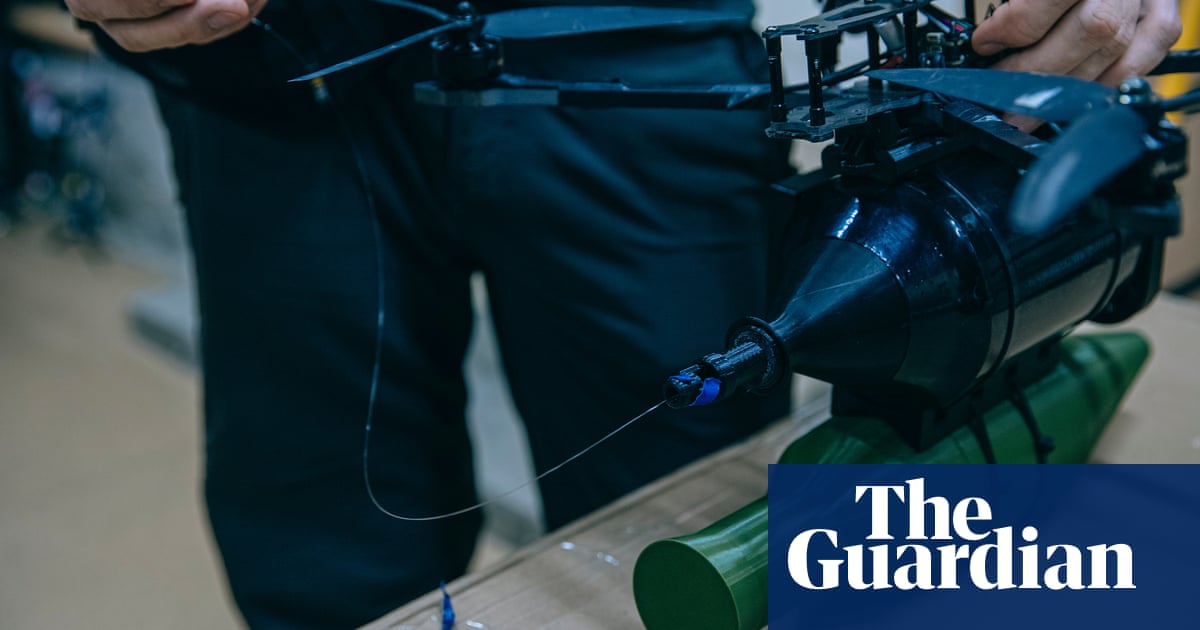At a secret workshop in Ukraine’s north-east, where about 20 people assemble hundreds of FPV (first person view) drones, there is a new design. Under the frame of the familiar quadcopter is a cylinder, the size of a forearm. Coiled up inside is fibre optic cable, 10km (6 miles) or even 20km long, to create a wired kamikaze drone.
Capt Yuriy Fedorenko, the commander of a specialist drone unit, the Achilles regiment, says fibre optic drones were an experimental response to battlefield jamming and rapidly took off late last year. With no radio connection, they cannot be jammed, are difficult to detect and able to fly in ways conventional FPV drones cannot.
“If pilots are experienced, they can fly these drones very low and between the trees in a forest or tree line. If you are flying with a regular drone, the trees block the signal unless you have a re-transmitter close,” he observes. Where tree lined supply roads were thought safer, fibre optic drones have been able to get through.



This kind of idea is between genius and stupid.
It’s a cheap an easy solution to a lot of problem, and it sounds like the kind of proposal an intern would do
It’s neither, they’re spare wire reels for older tow missiles which were wired for the same reason.
TIL thanks,
I heard about wired torpedo but didn’t know it was also a thing for missiles
Yep, still used in combat too and chances are you’ve seen a video and just didn’t know.
Anytime you see a video filmed from behind a missile and it keeps making smingly random swirling jinking movements it’s likely to be a tow missile.
https://youtu.be/IsOHo0oAc0c
Curiously, the first wired torpedoes, you’d propel the torpedo forward by pulling on the wire that came out the back of it.
https://www.youtube.com/watch?v=qvtZIdSI1Yk
Sure, but a 20km attack radius in terms of something that can fly seems… Idk less than effective.
It would work for precision bombing nearby targets, but for long range strikes like Ukraine does, they need to be untethered.
But in those cases, i doubt they run remotely, rather they set a GPS destination and they use a combination of astral navigation and inertial navigation to hit their intended target, just like missiles.
Just much slower, smaller and lower flying missiles. Can’t shoot what you can’t see on radar.
They are generally tactical weapons, not strategic.
And here my civvy ass is goin “wait they’re different?”
When talking about attack drones, historically that has described an unmanned bomber that has significant range and strike capability. These are a strategic asset, operated far back from the front and making big-picture attacks. They replace cruise missiles and manned bombers.
The war in Ukraine has led to the first major deployment of tactical drones. These are relatively short range and operated in the field. Some are simply hobby drones rigged up to be able to drop a grenade, while others are flown straight into a target and explode. This article is talking about the latter, which is basically a replacement for anti-tank missiles.
When compared against a missile you have to have line of sight to guide to the target, a 20km range is a huge step up.
Oh. Dang yo, I didn’t even think about out of sight anti-tanl. That’s a huge step up. You’re no longer looking down the barrel of a 130mm(idk) gun hoping your missile hits before they fire
Drone manufacturer: “We’re having trouble with our drones getting jammed, any ideas?”
Intern: “I always use CAT6 for my pc”
Drone manufacturer: “You goddamn genius!”
Kids these days relying on wireless everything and don’t realize the security and reliability of a wired connection.